Earth once blared its presence into space with powerful radio and TV signals—then fell almost silent as we switched to digital and cable. In just a few fleeting decades, our planet’s once-booming “broadcast bubble” shrank to faint whispers, changing Earth’s radio signature. This reshapes our view of the Drake Equation and the Fermi Paradox. Discover why that brief broadcast window matters. Is it time for humankind to shift from passive listening (SETI) to actively waving hello to the stars with powerful, deliberate beacons (METI)?
1. Early Radio History and Speculation
Early radio transmissions were generally weak. Therefore, they likely did not penetrate the ionosphere. However, as technology advanced, Earth’s radio signature grew. It marked our planet’s cosmic presence.
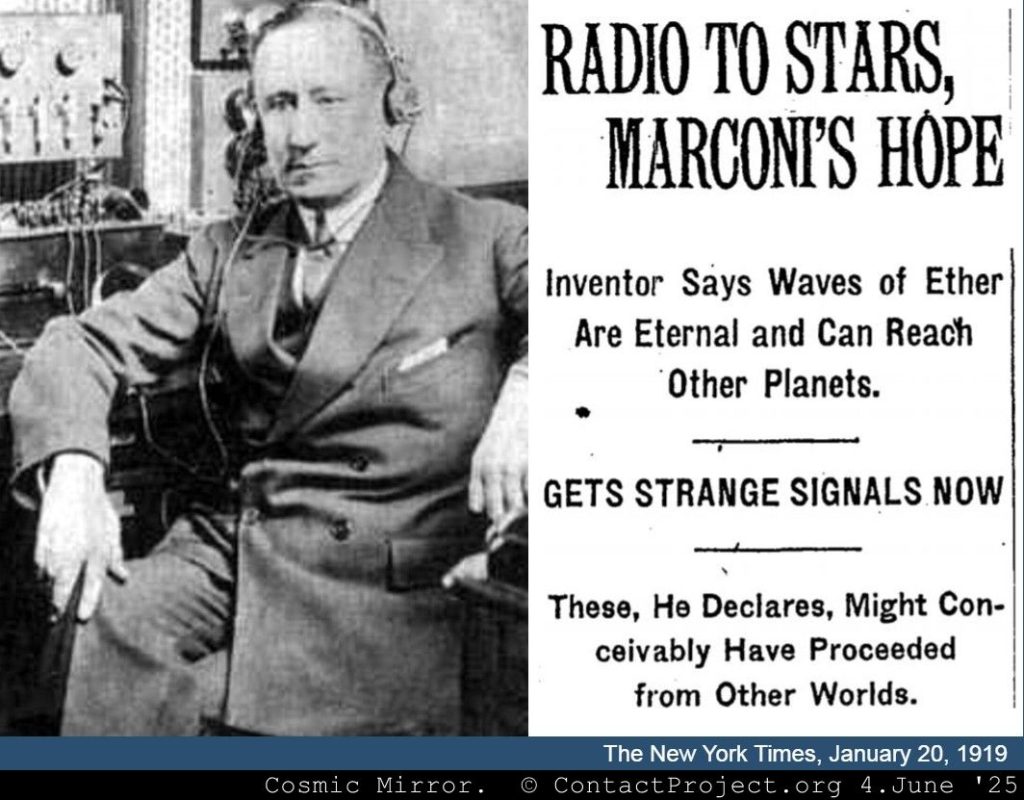
In the early years of the twentieth century, there was speculation that Extraterrestrials were trying to contact human beings by radio signals. In 1919, Marconi himself encouraged this speculation, claiming he was receiving strange transmissions resembling Morse code, possibly from outer space.
RKO Radio Pictures Inc., commonly known as RKO, was one of the first film production and distribution companies of Hollywoods Golden Age. RKO eventually expanded its operations to include television broadcasting.
From the beginning, their logo featured a transmission tower relaying a Morse code sequence: VVV A RADIO PICTURE VVVV. “VVV” in Morse code means “attention, incoming message”. “VVVV” may mean: Vi Veri Veniversum Vivus “The Force of Truth Comes Alive”
2. The Rise of Detectable Signals
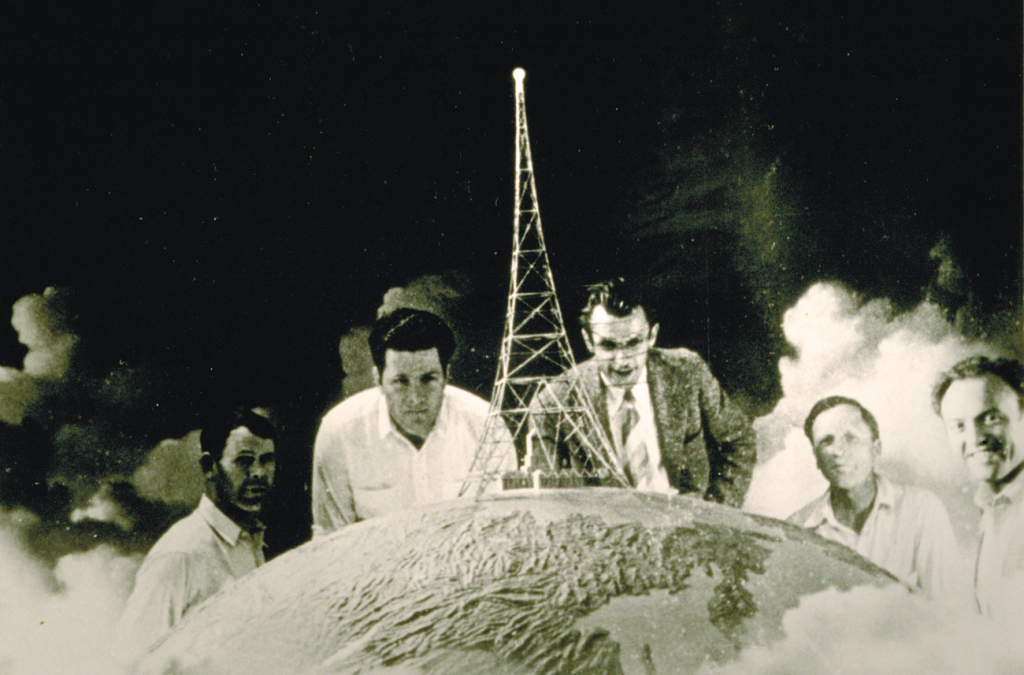
By 1931, about 25 TV stations in the U.S. were broadcasting television. And those who worry about Carl Sagan’s novel “Contact”: Germany began TV broadcasting in 1935. Any aliens watching Hitler speak in 1936 may have been more excited by Dolores Del Rio, Ginger Rogers, Fred Astaire and King Kong. (Picture: The special effects crew behind the set of “A Radio Picture” in 1929.)
The “Golden Age of Radio” and the subsequent rise of analog television broadcasting in the mid-20th century marked the first substantial contribution towards Earth’s technosignature. The total estimated radio power escaping into space reached tens to hundreds of megawatts by the 1970s. Powerful omnidirectional, analog signals characterized this period. This created an easily detectable “radio bubble” around Earth.
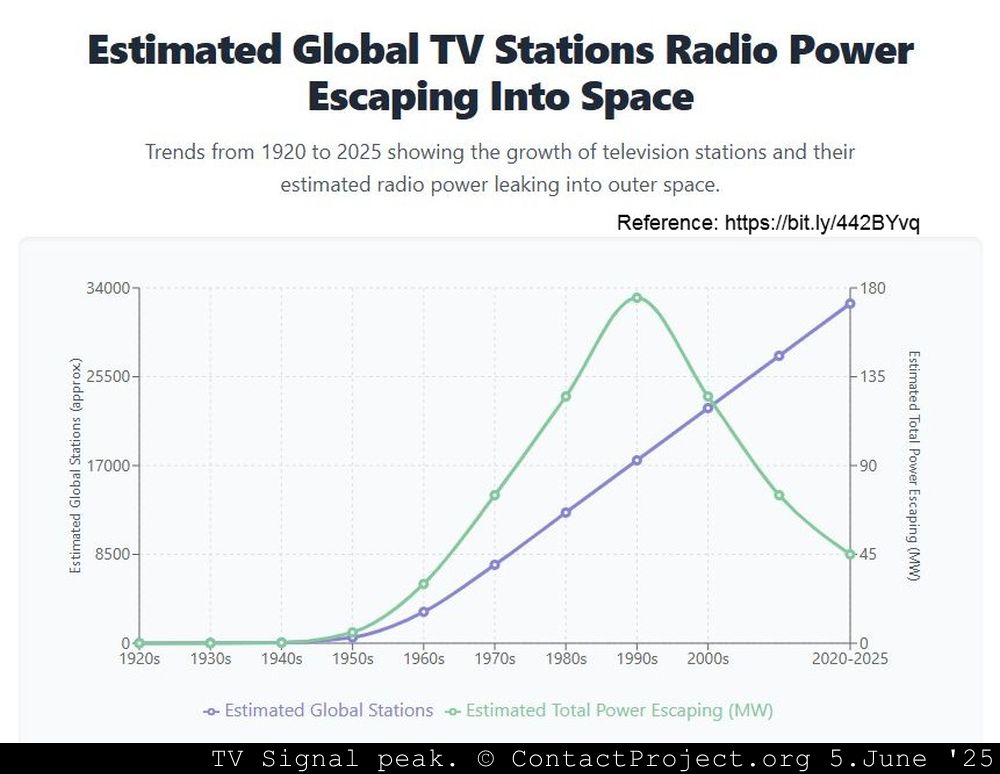
3. Earth as a Cosmic Mirror
In the Search for Extraterrestrial Intelligence (SETI), Earth’s radio emissions serve as a “cosmic mirror,” offering a tangible reference for the kinds of signals a distant, technologically advanced civilization might transmit—signals that, in turn, we might hypothetically detect.
4. The Decline of Broad Leakage
TV stations are growing, but their space-bound signal leakage is shrinking as they abandon over-the-air broadcasts. Our peak broad signal leakage—key to the Drake Equation—began falling as focused, less-leaky communication technologies emerged. This transition includes:
- Satellite Communications: Becoming widespread from the 1970s and 1980s onwards, satellite transmissions are generally directed point-to-point, reducing broad leakage.
- Cable Television and Fiber Optics: The increasing use of cable TV (reducing over-the-air television broadcasts) and later, fiber optic cables for a vast amount of data transmission. The internet significantly cut down on the amount of radio frequency energy escaping into space. This shift became more pronounced from the late 20th century into the 21st century.
- Digital Transmissions: Analog broadcasts, which were once more easily detected, are being replaced by digital signals. These digital signals are often more compressed and less likely to leak into space, contributing to Earth becoming “radio quiet” in terms of traditional broadcast leakage.
5. A Short Critique of the Drake Equation’s “L” Parameter
The Drake equation speculates on alien civilizations. In Drake’s original formulation, people often interpret “L” as the total lifespan of a technological civilization.

L – IS NOT simply the longevity of civilizations! Instead it’s the timespan that a civilization releases simple detectable signals.
Earth’s broad radio leakage lasted roughly from the 1930s until the 1980s–90s.
Thus, our planet broadcast Drake-equation-style signals for only about 40–60 years.
Then we switched to spread-spectrum digital, satellite, cable, and internet communications. Now only random radar pings and digital blips leak into space, quickly blending into cosmic background noise (CMB).
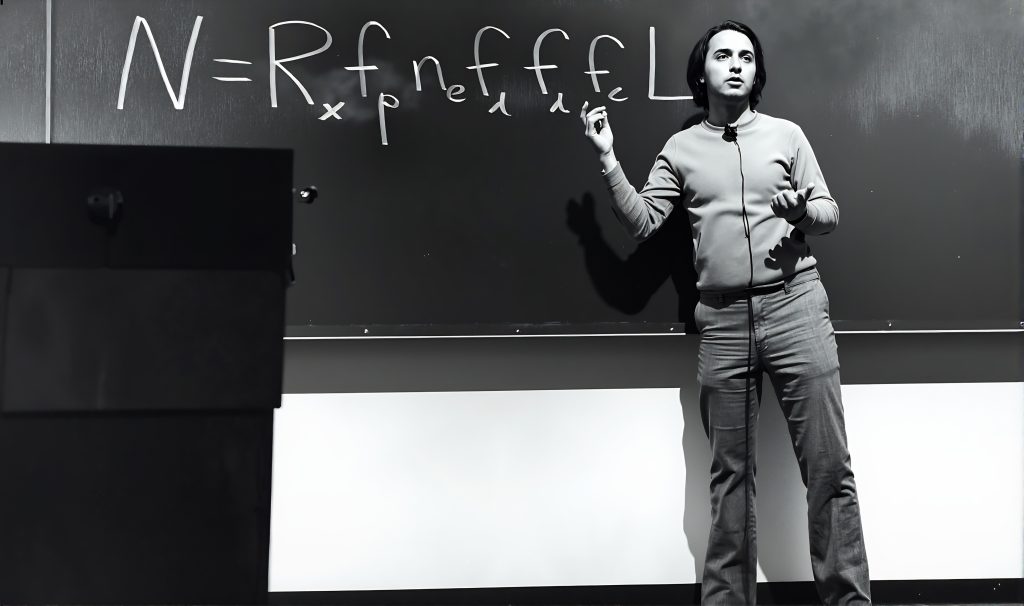
Although the Drake equation was a playful practice in the last millennium, by its own metric humankind would no longer exist, because we don’t release significant radio leakage anymore. Hence, the Drake equation is somewhat obsolete. If Earth civilization is a typical technological civilization, then we can expect other civilizations to leave a similar footprint of “L”—about fifty years. That leaves almost no time for any astronomer to detect a signal.
Ever wondered about the Fermi paradox and why we hear nothing of our cosmic neighbors in the radio spectrum? Here is one possible explanation:
We are now almost radio silent in the cosmos!
But because our “L” was only a mean 50 years, that doesn’t mean that we are extinct! It’s just that we have upgraded our communication system. This explains why the focus of SETI is shifting, away from radio signals, towards bio signatures and other technosignatures, not just radiowaves.
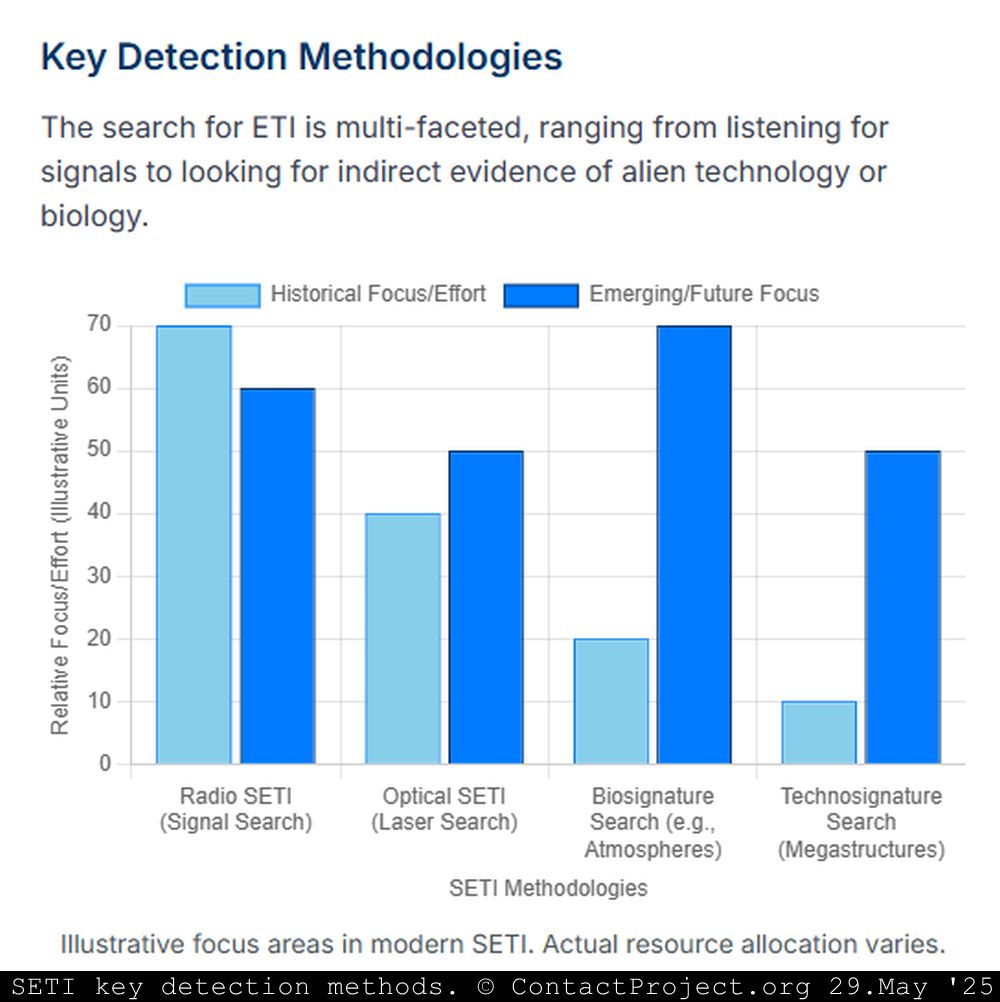
The “L” (Longevity) variable in the Drake Equation is thus not a simple constant even for a single civilization.
Actually, trying to detect interstellar Extraterrestrial civilizations by radio-signatures is a futile endeavour: it’s like scrolling through static on an old TV and hoping to catch an intergalactic episode of I Love Lucy that’s been bouncing around space for a billion years. No advanced technological civilization would be using radiowaves travelling at a mere 300000 km/sec for interstellar communication. That would be like sending smoke signals across the ocean. The only alien radiowaves we can ever hope to receive are leaked planetary signals and possibly navigational beacons.

6. Analysis of Earth’s Current Radio Signature
The latest study on Earth’s radiosignature is from Sofia Z. Sheikh et al 2025 AJ 169 118: Earth Detecting Earth: At What Distance Could Earth’s Constellation of Technosignatures Be Detected with Present-day Technology?
Sheikh calculated the detectability of four types of radio emissions from Earth. One conclusion was that an observer can detect planetary radar (Arecibo message from 1975) from the greatest distance. This graphic exemplifies this:

Sheikh overlooks that the Arecibo radar message was highly directional—only detectable along its precisely aimed, narrow path.
The Arecibo Message
The “Arecibo message” from 1974 lasted only 168 seconds. Frank Drake, Carl Sagan, and the other organizers of the boadcast did make it clear that the message was intended not as a genuine attempt to contact extraterrestrials, but as a symbolic demonstration of human technological capability.

Any serious attempt at communication with ETI would have required using Arecibo to send continuous signals into space, not just for three minutes. https://en.wikipedia.org/wiki/Arecibo_message
Arecibo telescope after its collapse (December 2021). Photo: Wikimedia Commons.
Altogether, humankind sent two dozen messages intended for an extraterrestrial audience into space from different telescopes. The total combined efforts in all of history to contact Extraterrestrial civilizations amounted to a measly 62.7 hours of transmissions. Not even three days. That is almost nothing in the billions of years of history of the universe, or life on Earth.
Ref.: Major METI transmissions (PDF 2)
The Arecibo message, with its directional 20 trillion watts (450 kw actual), was sent to the globular cluster M13, 25,000 light-years away. But calculations indicate the signal only penetrates about 12 000 light-years before the interstellar medium (ISM) absorbs it. Pity—what a clever demonstration of human technological prowess that was.
7. Breakdown of Earth’s Transmission- and Key Signal Types
Directional transmission (METI )– you choose a known exoplanet or promising star, minimizing exposure of one’s civilization by targeting needles in haystack, amongst 300- 500 million stars. Takes forever. That is the current strategy, based on the Dark Forest Hypothesis.
Omnidirectional transmission (unintentional METI) – “everyone in the Galaxy” can eavesdrop; historically Earth’s leakage (TV, Radio and nuclear expolsions) was unintended METI.
- Mobile Communication Leakage (omnidirectional): The Sheikh paper addressed leakage from LTE cellphone communication systems. Researchers estimate the impressive peak power leaking into space from mobile towers is approximately 4 GW. This pales into insignificance when we realize that an observer can only detect these signals from up to about 4 light-years away.
- Planetary Radar (highly directional): Many radio telescopes can function as radar systems—for example, to measure the distances of Solar System planets or distant asteroids and to assess their probability of impacting Earth. And for about 62.7 hours these systems have also been used to send messages to potential extraterrestrial civilizations.
The following key signal types were omitted from the study on Earth’s radio technosignatures in the Sheikh paper:
- Television Signals (omnidirectional): Earth’s early Radio and TV bubble was omnidirectional. An observer can detect it in every direction. An extraterrestrial audience could theoretically detect analog television signals—which began broadcasting in the 1930s—from up to 111 light-years away, representing a historical “radio bubble” of our planet’s past emissions. Broadcasters transmitted these signals, which operated in the VHF and UHF ranges, with megawatts of power.
- Radio Signals (omnidirectional): In contrast, AM and FM radio signals, do not penetrate into space as effectively as higher-frequency signals. While they are powerful enough for terrestrial reception, their intensity diminishes rapidly with distance, limiting their ability to escape Earth’s immediate vicinity into deep space.
- Radar (directional): The post–World War II era saw significant, continuous growth in radar systems—military, air-traffic-control, and weather—which, despite their pulsed nature, delivered consistently high average power thanks to their high operating frequencies and widespread deployment. By the 2000s, radar emissions into space were estimated at several hundred megawatts. Radar is not omnidirectional. If ETI had instrumentation comparable to the Square Kilometre Array (SKA), they might detect our radar transmissions from distances up to approximately 300 light-years.
- Military Radar (directional): Military radar systems are among the most powerful signals intentionally emitted from Earth. While specific power levels are often not publicly detailed, they are generally described as “significant”. A key characteristic of military radar is its directionality. These signals are designed to be highly directional, focusing their energy into narrow beams to achieve precise detection and tracking of targets. This focused power allows them to be very strong within their beam, making them highly detectable if an extraterrestrial observer is precisely aligned with that beam.
- Nuclear Explosions (omnidirectional): Humankind has detonated 2,000 nuclear bombs since 1945. The Russian Tsar Bomba of 1961 was the most powerful, and its radio emissions were ten billion times stronger than the Arecibo message.

Using the link-budget formula (PDF 3), we calculate that the Tsar Bomb electromagnetic pulse (PDF 4) could have been (or will be) detected by advanced radiotelescope technology (SKA2) out to roughly 36,000 light-years.
Looking ahead, the capabilities of a more highly advanced extraterrestrial civilization might extend that range to about 1.17 million light-years. That is enough to encompass the volume of the Milky Way, which is estimated to contain 300–500 million habitable planets. Several dwarf galaxies also lie within this volume of space. The thermonuclear Tsar Bomb explosion was by far the strongest radio signal that Earth has ever sent into space.
SETI scientists argue that the short duration of nuclear electromagnetic pulses makes their detection unlikely. That may have been true if those EMP had been the only radio pulses coming from Earth. But as a matter of fact, Earth had been making waves for decades before the barrage of nuclear tests ended. The expanding TV and radio bubble made sure of that. And those broadcasts transmitted 24/7.
8. Challenges of Interstellar Detection: Signal Degradation and Cosmic Noise
How Space Wears Down Radio Signals: Distance and the Interstellar Medium
The journey of any radio signal across 10,000 light-years is governed by the inverse square law, which causes a dramatic reduction in signal intensity. Beyond simple weakening, the interstellar medium (ISM) acts as a complex distorting filter. The ISM gas between the stars can spread out a broadband signal over time. Tiny variations in electron density scatter the waves. That scattering not only stretches the signal in time and space but also produces rapid, unpredictable flickers in intensity. These scintillations can make a message impossible to decode. Such distortions get much worse at lower frequencies. That is why astronomers favor the 1–10 GHz “microwave window”, the best range for sending signals across interstellar space.
The Cosmic Veil: Distinguishing Signals from Noise
Space isn’t silent—it’s alive with radio chatter. From our Sun’s booming broadcasts to distant black holes belting out jets of particles, the universe drips with natural “noise.” that can easily mask any deliberate signal we send or hope to detect. Any terrestrial signal must be distinguished from the overwhelming natural radio background of the cosmos. This background includes pervasive sources like the Cosmic Microwave Background (CMB), which establishes a fundamental noise floor, and galactic background noise from synchrotron radiation. And are pulsars natural phenomena, mimicking certain characteristics of intelligent signals, or are they intelligent signals, misunderstood by humankinds igorance of the engineering capapilities of a Kardashev type III and IV ciilization? These questions pose a significant challenge for recognition.
9. Conclusion: The Reality of Interstellar Eavesdropping
The Hypothetical Tech Needed for Extraterrestrial Eavesdropping
For an extraterrestrial civilization to detect Earth’s radio technosignature from 10,000 light-years, it would require radio astronomy technology vastly superior to current human capabilities.

This would likely involve collecting areas orders of magnitude larger than our most powerful telescopes (potentially equivalent to tens of thousands of Arecibo-sized dishes), coupled with extremely low system temperatures (achieved through cryogenic cooling), wide bandwidths, and very long integration times to achieve the necessary signal-to-noise ratio.
The Real Odds: Why Earth’s Radio Shouts Are Mostly Whispers Across the Galaxy
In conclusion, while the theoretical detectability of Earth’s most powerful, directed radio emissions extends to galactic distances, the practical challenges of signal attenuation, interstellar distortion, and overwhelming cosmic noise mean that the vast majority of Earth’s radio footprint remains localized. The successful detection of Earth’s intelligent signal from 10,000 light-years would signify an extraordinary level of technological advancement on the part of the observing extraterrestrial civilization, far surpassing humanity’s current capabilities. This underscores the profound difficulty in interstellar communication and provides critical perspective for humanity’s ongoing search for extraterrestrial intelligence.
Tired of Waiting for E.T. to Call?
It’s Time to Make the First Move.
Our civilization’s radio tech signature offers a stark revelation: waiting passively to be discovered is a strategy doomed by the physics of communication and the trajectory of technology. Our own history serves as a cosmic mirror, reflecting the likely silence of other advanced societies. The prospects of being detected by chance are remarkably slim; our most powerful, intentional messages have been mere momentary shouts aimed with laser-like precision at impossibly small targets. Simultaneously, our best chance for accidental discovery—the omnidirectional “radio bubble”…is rapidly fading as we become more efficient and, consequently, “radio quiet.”
If we accept this fleeting, whispering technological phase as typical, we must conclude that waiting for another civilization’s leaky signals is as futile as them waiting for ours. The Great Silence may not be a lack of life, but a universe of civilizations that, like us, have outgrown noisy, inefficient broadcasting.
This realization demands a shift in strategy. To stand any chance of being detected, or of detecting others, we must embrace Active METI (Messaging to Extraterrestrial Intelligence). We cannot hope to find a needle in a cosmic haystack by chance; we must listen for the magnets. By understanding that we would need to build a powerful, sustained, and deliberate beacon to announce our presence, the cosmic mirror shows us precisely what we should be searching for. Committing to an active, intentional transmission is therefore not just an act of introduction; it is the most logical step toward refining our own search, transforming our understanding of our own limitations into the very tool needed to finally detect a kindred signal in the void.
This article presented new independent research on Earth’s historical radio signature in the cosmos, the total duration and strength of modern METI transmissions and -by comparison- the detectability of thermonuclear explosions by extraterrestrial civilizations.
Erich Habich-Traut
References used in this text:
- PDF: Earth’s Evolving Radio Footprint: A Megawatt Analysis of Anthropogenic Emissions in Outer Space (1900-2025)
- PDF: Major METI Transmissions
- PDF: TSAR Bomba Nuclear EMP detectability by Extraterrestrial Civilization
- PDF: Radio power comparison Tsar Bomba (1961) vs. Arecibo SETI Signal (1974)
- Article: Earth Detecting Earth: At What Distance Could Earth’s Constellation of Technosignatures Be Detected with Present-day Technology?
